Papers by Nashwa Nashaat-Sobhy
http://www.webs.ulpgc.es/lfe/forthcoming_articles/forthcoming_articles.html

Journal of English-Medium Instruction
This paper reviews how higher education should rethink the Continuous Professional Development (C... more This paper reviews how higher education should rethink the Continuous Professional Development (CPD) of their teaching staff, so that English-Medium Education (EME) is integrated in addressing issues of sustainability (solving problems that threaten humanity and the quality of life). Four focal points are selected: promoting inclusive and equitable quality education; shifting to a transdisciplinary approach; dialogic teaching and learning; and digitalising EME practices. The paper, which draws on research findings, presents an overview of the current contexts of teacher training for EME in Europe, with specific examples of available best practices. This is followed by a vision for future directions to link internationalisation of education and EME to the Sustainable Development Goals (SDGs) with a focus on educational development fit for global engagement. The current importance of training EME lecturers for teaching in English is acknowledged, but it is stressed that professional d...

Journal of English-Medium Instruction , 2022
This paper reviews how higher education should rethink the Continuous Professional Development (C... more This paper reviews how higher education should rethink the Continuous Professional Development (CPD) of their teaching staff, so that English-Medium Education (EME) is integrated in addressing issues of sustainability (solving problems that threaten humanity and the quality of life). Four focal points are selected: promoting inclusive and equitable quality education; shifting to a transdisciplinary approach; dialogic teaching and learning; and digitalising EME practices. The paper, which draws on research findings, presents an overview of the current contexts of teacher training for EME in Europe, with specific examples of available best practices. This is followed by a vision for future directions to link internationalisation of education and EME to the Sustainable Development Goals (SDGs) with a focus on educational development fit for global engagement. The current importance of training EME lecturers for teaching in English is acknowledged, but it is stressed that professional development must evolve to include emerging global teaching and learning competences. The last section is dedicated to practical recommendations for all EME community members.

Language Teaching for Young Learners, 2021
In Content and Language Integrated Learning (CLIL) contexts, students are expected to express dis... more In Content and Language Integrated Learning (CLIL) contexts, students are expected to express disciplinary knowledge in a second/foreign language. One construct that has proven useful for the identification and realization of language functions in disciplinary knowledge is Dalton-Puffer's (2013) model of cognitive discourse functions (CDFs). Additionally, Systemic Functional Linguistics (SFL) has already been proven useful for distinguishing lexico-grammatical features that characterise different CDFs in CLIL students' productions (e.g., Nashaat-Sobhy & Llinares, 2020; Evnitskaya & Dalton-Puffer, 2020). In this article, we use SFL to analyse the oral and written realisations of the CDF Define by 6th grade students participating in a CLIL program in Madrid, Spain. A total of 83 students responded to the same prompt (on science) in writing (in the form of a blog) as well as orally (in the form of an interview). In the oral interviews the co-construction of definitions by the students with the interviewer (researcher) and another peer are explored using the notion of Legitimation Code Theory and the concept of semantic waves (Maton, 2013). The analysis of students' definitions is also related to primary CLIL teachers' evaluations using comparative judgement.
Keywords: CLIL, systemic functional linguistics, semantic waves, oral and written definitions, comparative judgement
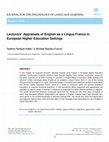
Journal for the Psychology of Language Learning (JPLL) , 2020
In this chapter we analyzed lecturers' attitudes towards using English in European Higher Educati... more In this chapter we analyzed lecturers' attitudes towards using English in European Higher Education settings. Twenty-eight university teachers were brought together from thirteen universities across six European countries for an online training for teachers in English Medium Instruction (EMI) settings. The lecturers' written exchanges about English as an academic Lingua Franca (ELF) in one of the training modules were the target of our study. These exchanges (110 posts) were coded and analyzed using Martin and White's (2005) Appraisal Theory, which is a model of evaluation within the general theoretical framework of systemic functional linguistics. In this framework, affect, judgement and appreciation are regarded as regions (types) of feelings in interpersonal language that reflect attitude (positive or negative). The results showed that teachers' exchanges about ELF are interwoven with other types of English, in which they discussed different stakeholders and aspects of English, towards which their attitudes vary, which points to the multidimensionality of attitudes towards EMI. The results also show that appreciation and judgment regions were used more than affect in their language when discussing the use of English in Higher Education (HE).
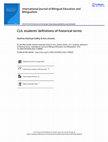
International Journal of Bilingual Education and Bilingualism, 2020
The ability to manage specific forms of disciplinary expression –
Languages of Schooling – is reg... more The ability to manage specific forms of disciplinary expression –
Languages of Schooling – is regarded as a factor of academic success
(Council of Europe recommendations – Council of Europe CM/Rec.
[2014]. Recommendation of the Committee of Ministers to Member States
on the Importance of Competences in the Language(s) of Schooling for
Equity and Quality in Education and for Educational Success. Accessed
December 25, 2018. https://search.coe.int/cm/Pages/result_details.aspx?
ObjectID=09000016805c6105). One of the core discursive functions
students perform across academic subjects is defining, which is part of
the inventory of descriptors for the language of schooling (e.g. Beacco
[2010]. Items for a Description of Linguistic Competence in the Language
of Schooling Necessary for Teaching/Learning History (End of Obligatory
Education). Strasbourg: Language Policy Division, Council of Europe). This
study addresses defining as a component of the language of schooling
by which CLIL students express specialized knowledge across languages,
educational levels and fields (see Coffin [2006b]. Historical Discourse. The
Language of Time, Cause and Evaluation. London: Bloomsbury Publishing,
Continuum). We elicited, analysed and compared students’ written
definitions in English (L2) and Spanish (L1) of two different historical
fields in primary (6th grade) and secondary (8th grade). For this purpose,
we applied an analysis scheme that merges Trimble’s ([1985]. English for
Science and Technology: A Discourse Approach. Cambridge: Cambridge
University Press) definitional construct and Systemic Functional
Linguistics (Halliday and Matthiessen [2014]. An Introduction to
Functional Grammar. London: Hodder; Martin [2013]. “Embedded
Literacy: Knowledge as Meaning.” Linguistics and Education 24: 23–37).
Our results show that while students produced more definitions in
English in the higher educational level, the differences in their
realizations are attributed more to the field being defined. The study has
also shown no differences in the frequency and type of definitions
across languages.

Revista Española de Lingüística Aplicada/Spanish Journal of Applied Linguistics, 2018
This study is a mixed-method, cross-sectional study that compares the acquisition of request modi... more This study is a mixed-method, cross-sectional study that compares the acquisition of request modification in the productions of two secondary school groups (15–16 years old) in two school programs: content and language integrated learning (CLIL) and traditional mainstream (non-CLIL). A total of 192 requests were gathered from both groups by means of an elicitation instrument (a Written Discourse Completion Test – WDCT). The requestive pragmatic moves (external and internal modifiers and request strategies) were analysed according to their pragmatic functions (softeners and aggravators) and a data-driven taxonomy of request modification was elaborated in line with previously developed taxonomies (Blum-Kulka et al., 1989; Alcón Soler et al., 2005) for the data analysis. The results showed that both groups share similarities typical of foreign language learners. Nonetheless, significant statistical differences between them indicated that the CLIL group had a fuller repertoire of reques...
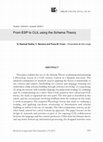
This paper explains the use of the Schema Theory in planning and preparing a Physiology lesson in... more This paper explains the use of the Schema Theory in planning and preparing a Physiology lesson in a CLIL tertiary context in a Spanish university. The adopted combination of methods used in applying the theory is transferable to
any context and subject. Scaffolding for content and language learning was undertaken using schema-building through activities involving: (1) sequencing;
(2) using an exercise with causality language for purposeful reading (3) outlining; and (4) commentating on a video. Since CLIL practices have often lead CLIL theory, the study is organized into two parts. The first part is described in this
article, and the second part, involving feedback from the students in this study, is work in progress. The required Physiology lesson lent itself to outlining a reading, and applying top-down structuring of information and schema
building, as well as to the use of causality. The video commentary activity, on the other hand, catered for a more bottom-up approach. The paper focuses on the design of materials and activities as part of the ongoing CLIL collaboration between the language and the content professors. Other than the Schema theory and top-down bottom-up information processing, the designed activities were based on the principles of social constructivism through language scaffolding and peer collaboration.
Book Chapters by Nashwa Nashaat-Sobhy
Informational Environments,
This publication was authored by Philip H. Winne, Jovita M. Vytasek, Alexandra Patzak, Mladen R... more This publication was authored by Philip H. Winne, Jovita M. Vytasek, Alexandra Patzak, Mladen Rakovic, Zahia Marzouk, Azar Pakdaman-Savoji, Ilana Ram, Donya Samadi, Michael P.C. Lin, Arita Liu, Amna Liaqat, Nashwa Nashaat-Sobhy, Zahra Mozaffari, Jason Stewart-Alonso, and John C. Nesbit.

TESOL TEACHER EDUCATION IN A TRANSNATIONAL WORLD TURNING CHALLENGES INTO INNOVATIVE PROSPECTS , 2021
In this chapter we investigate how the Two2Tango(T2T) program (a transnational community of pract... more In this chapter we investigate how the Two2Tango(T2T) program (a transnational community of practice) supports in-service TESOL teachers across six European countries to construct their professional identities. The analytical tool used is the recently developed ROADMAPPING framework (Dafouz & Smit, 2016, 2020), which is an integrative applied linguistic model that captures the dynamic nature of English medium education in multilingual university settings (EMEMUS). The findings throw light on the linguistic and pedagogical needs of EME lecturers, who as L2 speakers of English are part of the broader TESOL community, and whose needs depict the current foreign language education landscape.
The chapter first explains the rapid expansion of EME, the main features of the ROADMAPPING model, and the role of teachers’ identities on their teaching practices. Second, it describes the context, participants, and dataset used. Third, it displays and discuss the findings. Finally, possible practical implications for TESOL and directions for future research are provided.
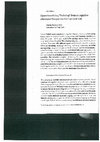
Knowledge Mobilization in TESOL, 2019
Dalton-Puffer's (2016) construct of cognitive discourse function (CDF) invites TESOL and CLIL (Co... more Dalton-Puffer's (2016) construct of cognitive discourse function (CDF) invites TESOL and CLIL (Content and Language Integrated Leaming) educators to make "the process of thought available for learning" and to enable students to verbalize these thoughts. The construct includes seven interdisciplinary academic functions with different macro-realizers and internal structures, which are classifying, defining, describing, evaluating, explaining, exploring, and reporting. The point of departure for this chapter was the operationalization of ‘defining’ as a CDF for learner use (Dalton-Puffer, 2016, pp. 29-54). This operationalization took the form of a template that was extended to a group of tertiary students in an English Medium Instruction program that adopts CLIL principles. The definition template, illustrating the possible macro-moves when defining, was incorporated in different activities in a core non-language subject in the degree of education between February and May 2016. Students' perceptions about the template and the activities were surveyed anonymously, which together with the students' actual use of the template and their written definitions were used to determine the usefulness of the initiative.
Applied Linguistics Perspectives on CLIL, 2017
The study compares how three groups of learners at different educational levels
in CLIL, post-CLI... more The study compares how three groups of learners at different educational levels
in CLIL, post-CLIL and EFL classes modify their requests which were elicited by
means of a written discourse completion task with two situations (different power
relations). Data analysis is based on earlier request taxonomies (Alcón-Soler
et al. 2005; Blum-Kulka et al. 1989), but the study also introduces new pragmatic
features that appeared in the learners’ data. Qualitative and quantitative differences
point to a duality in how learners use softening and aggravating request
modifications, attributed to insufficient sociopragmatic knowledge. Among
other finer results, the study shows that CLIL, as an educational approach, does
not necessarily contribute to enhancing learners’ pragmatic competence if seen
through the lens of making requests.

Learning Second Language Pragmatics beyond Traditional Contexts (Linguistic Insights – Studies in language Communication), 2018
Chapter 6. CLIL students' pragmatic competence: a comparison between naturally-occurring and elic... more Chapter 6. CLIL students' pragmatic competence: a comparison between naturally-occurring and elicited requests This study aims to compare the modifiers and strategies that students in content and language integrated programs (CLIL students) use when formulating naturalistic and elicited requests. A sample of 77 grade 10 students participated in this study; 24 students generated 60 naturalistic requests while they worked in groups on a history task and another 53 students generated 45 elicited requests in response to a written discourse completion test prompt (WDCT). The comparison showed that students used similar pragmatic categories (the marker please, direct imperatives, indirect query preparatory conditions and grounders) in both data sets. However, the naturally-occurring requests included a significantly higher number of direct strategies, whereas the WDCT requests had significantly more query preparatory conditions. We conclude that the routinized exchanges occurring during group-work do not always have the potential to fully reflect L2 learners' knowledge of request modification. In contrast, an elicitation prompt, like the one used in this study, can push students to employ more or different requestive pragmatic features.
Talks by Nashwa Nashaat-Sobhy







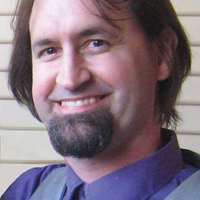



Uploads
Papers by Nashwa Nashaat-Sobhy
Keywords: CLIL, systemic functional linguistics, semantic waves, oral and written definitions, comparative judgement
Languages of Schooling – is regarded as a factor of academic success
(Council of Europe recommendations – Council of Europe CM/Rec.
[2014]. Recommendation of the Committee of Ministers to Member States
on the Importance of Competences in the Language(s) of Schooling for
Equity and Quality in Education and for Educational Success. Accessed
December 25, 2018. https://search.coe.int/cm/Pages/result_details.aspx?
ObjectID=09000016805c6105). One of the core discursive functions
students perform across academic subjects is defining, which is part of
the inventory of descriptors for the language of schooling (e.g. Beacco
[2010]. Items for a Description of Linguistic Competence in the Language
of Schooling Necessary for Teaching/Learning History (End of Obligatory
Education). Strasbourg: Language Policy Division, Council of Europe). This
study addresses defining as a component of the language of schooling
by which CLIL students express specialized knowledge across languages,
educational levels and fields (see Coffin [2006b]. Historical Discourse. The
Language of Time, Cause and Evaluation. London: Bloomsbury Publishing,
Continuum). We elicited, analysed and compared students’ written
definitions in English (L2) and Spanish (L1) of two different historical
fields in primary (6th grade) and secondary (8th grade). For this purpose,
we applied an analysis scheme that merges Trimble’s ([1985]. English for
Science and Technology: A Discourse Approach. Cambridge: Cambridge
University Press) definitional construct and Systemic Functional
Linguistics (Halliday and Matthiessen [2014]. An Introduction to
Functional Grammar. London: Hodder; Martin [2013]. “Embedded
Literacy: Knowledge as Meaning.” Linguistics and Education 24: 23–37).
Our results show that while students produced more definitions in
English in the higher educational level, the differences in their
realizations are attributed more to the field being defined. The study has
also shown no differences in the frequency and type of definitions
across languages.
any context and subject. Scaffolding for content and language learning was undertaken using schema-building through activities involving: (1) sequencing;
(2) using an exercise with causality language for purposeful reading (3) outlining; and (4) commentating on a video. Since CLIL practices have often lead CLIL theory, the study is organized into two parts. The first part is described in this
article, and the second part, involving feedback from the students in this study, is work in progress. The required Physiology lesson lent itself to outlining a reading, and applying top-down structuring of information and schema
building, as well as to the use of causality. The video commentary activity, on the other hand, catered for a more bottom-up approach. The paper focuses on the design of materials and activities as part of the ongoing CLIL collaboration between the language and the content professors. Other than the Schema theory and top-down bottom-up information processing, the designed activities were based on the principles of social constructivism through language scaffolding and peer collaboration.
Book Chapters by Nashwa Nashaat-Sobhy
The chapter first explains the rapid expansion of EME, the main features of the ROADMAPPING model, and the role of teachers’ identities on their teaching practices. Second, it describes the context, participants, and dataset used. Third, it displays and discuss the findings. Finally, possible practical implications for TESOL and directions for future research are provided.
in CLIL, post-CLIL and EFL classes modify their requests which were elicited by
means of a written discourse completion task with two situations (different power
relations). Data analysis is based on earlier request taxonomies (Alcón-Soler
et al. 2005; Blum-Kulka et al. 1989), but the study also introduces new pragmatic
features that appeared in the learners’ data. Qualitative and quantitative differences
point to a duality in how learners use softening and aggravating request
modifications, attributed to insufficient sociopragmatic knowledge. Among
other finer results, the study shows that CLIL, as an educational approach, does
not necessarily contribute to enhancing learners’ pragmatic competence if seen
through the lens of making requests.
Talks by Nashwa Nashaat-Sobhy
Keywords: CLIL, systemic functional linguistics, semantic waves, oral and written definitions, comparative judgement
Languages of Schooling – is regarded as a factor of academic success
(Council of Europe recommendations – Council of Europe CM/Rec.
[2014]. Recommendation of the Committee of Ministers to Member States
on the Importance of Competences in the Language(s) of Schooling for
Equity and Quality in Education and for Educational Success. Accessed
December 25, 2018. https://search.coe.int/cm/Pages/result_details.aspx?
ObjectID=09000016805c6105). One of the core discursive functions
students perform across academic subjects is defining, which is part of
the inventory of descriptors for the language of schooling (e.g. Beacco
[2010]. Items for a Description of Linguistic Competence in the Language
of Schooling Necessary for Teaching/Learning History (End of Obligatory
Education). Strasbourg: Language Policy Division, Council of Europe). This
study addresses defining as a component of the language of schooling
by which CLIL students express specialized knowledge across languages,
educational levels and fields (see Coffin [2006b]. Historical Discourse. The
Language of Time, Cause and Evaluation. London: Bloomsbury Publishing,
Continuum). We elicited, analysed and compared students’ written
definitions in English (L2) and Spanish (L1) of two different historical
fields in primary (6th grade) and secondary (8th grade). For this purpose,
we applied an analysis scheme that merges Trimble’s ([1985]. English for
Science and Technology: A Discourse Approach. Cambridge: Cambridge
University Press) definitional construct and Systemic Functional
Linguistics (Halliday and Matthiessen [2014]. An Introduction to
Functional Grammar. London: Hodder; Martin [2013]. “Embedded
Literacy: Knowledge as Meaning.” Linguistics and Education 24: 23–37).
Our results show that while students produced more definitions in
English in the higher educational level, the differences in their
realizations are attributed more to the field being defined. The study has
also shown no differences in the frequency and type of definitions
across languages.
any context and subject. Scaffolding for content and language learning was undertaken using schema-building through activities involving: (1) sequencing;
(2) using an exercise with causality language for purposeful reading (3) outlining; and (4) commentating on a video. Since CLIL practices have often lead CLIL theory, the study is organized into two parts. The first part is described in this
article, and the second part, involving feedback from the students in this study, is work in progress. The required Physiology lesson lent itself to outlining a reading, and applying top-down structuring of information and schema
building, as well as to the use of causality. The video commentary activity, on the other hand, catered for a more bottom-up approach. The paper focuses on the design of materials and activities as part of the ongoing CLIL collaboration between the language and the content professors. Other than the Schema theory and top-down bottom-up information processing, the designed activities were based on the principles of social constructivism through language scaffolding and peer collaboration.
The chapter first explains the rapid expansion of EME, the main features of the ROADMAPPING model, and the role of teachers’ identities on their teaching practices. Second, it describes the context, participants, and dataset used. Third, it displays and discuss the findings. Finally, possible practical implications for TESOL and directions for future research are provided.
in CLIL, post-CLIL and EFL classes modify their requests which were elicited by
means of a written discourse completion task with two situations (different power
relations). Data analysis is based on earlier request taxonomies (Alcón-Soler
et al. 2005; Blum-Kulka et al. 1989), but the study also introduces new pragmatic
features that appeared in the learners’ data. Qualitative and quantitative differences
point to a duality in how learners use softening and aggravating request
modifications, attributed to insufficient sociopragmatic knowledge. Among
other finer results, the study shows that CLIL, as an educational approach, does
not necessarily contribute to enhancing learners’ pragmatic competence if seen
through the lens of making requests.